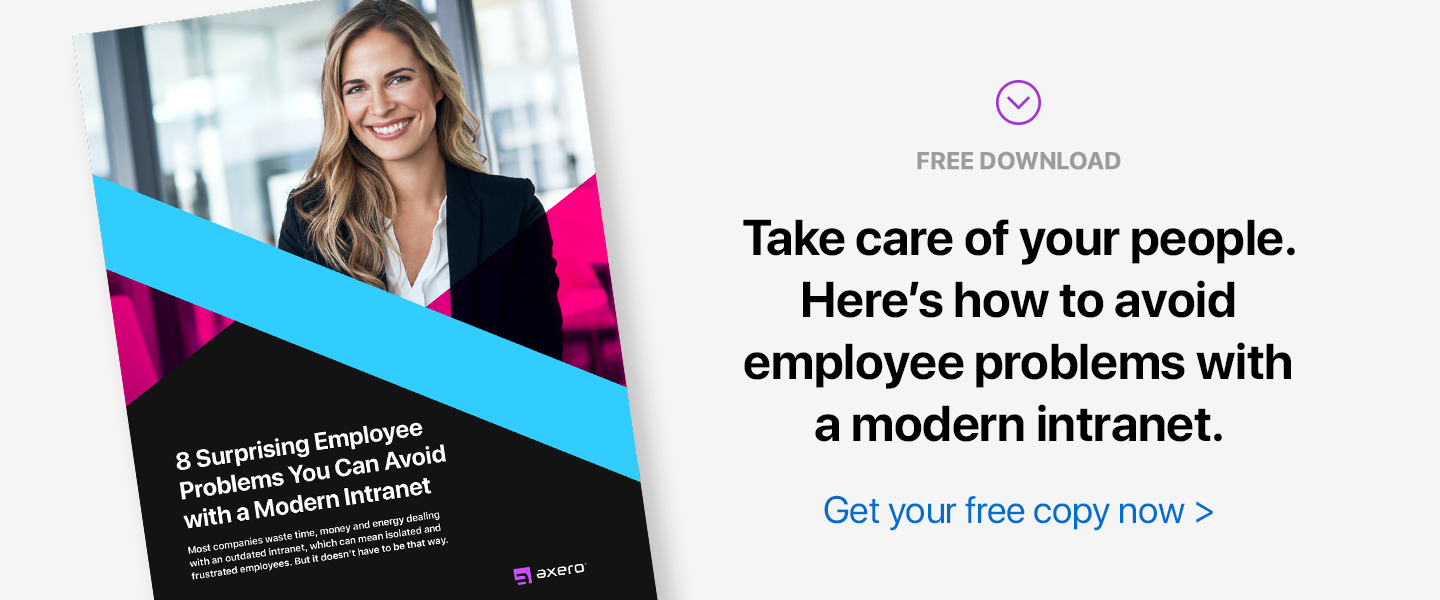Getting employees to give honest feedback. Equally challenging is to get leadership to implement employee ideas
— Internal Comms Program Manager
So far on this blog, we’ve heard from five internal communications managers. We’ve discussed technical points …
- How to Communicate to a Large, Diverse and Widespread Workforce
- How to Make Your Intranet Work for You
- What’s the Latest in Internal Communications
… and battled existential problems …
Today, thanks to the Internal Communications Manager No. 6, we are finally getting somewhere. From the employee engagement point of view, that is. With rare exception, corporate communications aim to engage. However, you’re unlikely to succeed unless you know your employees’ “hot buttons.” But how would you know that if they don’t talk to you?
A few posts ago, we heard from a Rewards & Performance Manager with a similar challenge (How to Get People to Speak Their Minds). I suspected a breach of trust between management and employees and made a few suggestions for pivoting off the warpath.
Today’s case points in the same direction. As this Manager found out, getting to the bottom of employee concerns is not always as simple as asking the right question. She even told us why these employees would rather keep their mouths shut: management won’t do anything, anyway. So, what’s an Internal Comms Program Manager to do?
When the company and employees don’t see eye to eye, it’s time to relate to each other human to human. The formal channels of communication available to this Manager seem to be broken. So, her best bet is to try the informal ones.
By informal, I don’t just mean dim the lights and hand them a beer—I’m getting there shortly. First, I’d like to recall the ingrained evolutionary habits that have helped us survive and strive as a species. They still come in handy when we find ourselves in a bind.
The following ideas are from Robert Cialdini’s Influence. It’s a book about getting people to comply with all sorts of requests, from answering calls for help to taking poison. The principles he describes are so powerful that we need special knowledge to defend against them.
In the book, he dubs them “weapons of mass influence,” and they are dangerous when they fall into the wrong hands. But today, our purpose is a noble one. We want our Internal Comms Program Manager to build common ground and communicate with employees. And, according to Dr. Cialdini, she has a few good options to mix and match.
Bribe ‘Em with Food
Google’s famous rule states that no employee should be more than two-hundred feet away from food. The unusual perk has given rise to many speculations. From the obvious: “they never want you to leave the premises” to the official version that food fosters cross-departmental bonding and stimulates innovation. Everyone who has been to Google confirms that the eats there are highly stimulating. I have a story to prove it later in this post.
But maybe there’s another reason to shower employees with free snacks. Food puts people in an agreeable mood. And every civilization has taken advantage of this to conduct important business. Giving feedback is one business activity that mixes well with food. And, speaking of Google, no company asks for or receives more employee feedback. I’ll leave it to you, the reader, to connect the dots.
Invite Reciprocity
According to Cialdini, the reciprocity principle is so powerful that even when we receive a favor we did not ask for, we feel a strong obligation to respond in kind. To invite reciprocity, just be straight with employees when asking for feedback. Our Internal Comms Program Manager might admit there’s been bad blood between management and employees. She might also say that she knows first-hand how difficult it is to get management to act on employee ideas, yet it’s her job to start the conversation. Then shut up and let psychology work.
Get Social Proof
The astonishing fact is that she only needs one employee to honor her request publicly—ideally, a well-respected member of the group. Let’s say she’s running a focus group. She brought lunch for everyone and gave them time to chill out and enjoy their food. Next, she introduces her agenda with honest words about the project and her part in it.
By now the members of the group should feel hesitation between continuing to stonewall and cooperating. They would look to each other to gauge the socially acceptable course of action. The first one to speak sets the tone. If nobody steps forward, a good facilitator will read the group’s body language and encourage the person who seems most eager to break the silence.
Be the Authority
Cialdini says that humans are pre-programmed to seek out and obey authority. Because we do this instinctively rather than logically, our brains make split-second decisions based on minimal information. Clothes, body language, the tone and choice of words—anything can signal authority, with or without the help of a formal title.
Authority is very important when asking others to make a choice they would not otherwise make. Confidence often works better than a lengthy explanation. Don’t assume that people need a reason to give honest feedback. Just invite them to do so and focus on those that follow your lead.
Enlist Consistency
The consistency principle states that once people make up their minds, they tend to stand by their decision, even when their reasons for making it are no longer valid. Right now, the consistency principle is working against our Internal Comms Program Manager. But, if she can get some people to open up, she won’t need to worry so much about the leadership’s lack of response.
Assuming the company doesn’t outright squelch honest feedback, these employees will continue to voice their opinions and sway their co-workers to do the same. Cialdini points out that this behavior has less to do with any tangible results than with a newfound identity. (“I have good ideas!” “I am a leader!” “I’m not afraid to speak my mind!”) If anything, these employees may become more active in the future, as they wish to prove to themselves and others that they made the right choice.
So far, we’ve assumed that the company wants to hear from employees, even if it is slow in getting back to them. While this is the ideal scenario, it’s not the norm. The lack of trust we discussed earlier goes both ways. As a consequence, many management teams do not trust employees to say and do the right thing. It is as true of the old-fashioned hierarchical companies as the new-age egalitarian tech stars—like Google.
In August 2017, Google stunned the world by firing James Damore, an engineer who questioned its diversity policy. About a month earlier, the company hired Danielle Brown as its first-ever VP of Diversity, Integrity, and Governance. Ironically, the new VP’s first order of business was to silence dissenting voices. In a thoughtful, carefully worded memo, she assured employees that the company would continue down the same path, whether they liked it or not.
The scandal started innocently enough with Damore submitting routine feedback. At the time, Damore was a model Google employee. He had been recruited out of Harvard’s Ph.D. program in systems biology and was promoted twice in three years. He was working in Google’s mission-critical search division, developing search-by-video software. By his admission, he had never owned an iPhone, was in love with all things Google, and evangelized the brand to his family and friends.
In July 2017, Damore attended Google’s mandatory unconscious bias training, where he saw and heard things that didn’t sit well with him. (For more ways to set off the bullshit detector in your employees, see What is a Shit Sandwich?) He then did what a trained scientist would do: try to reconcile his views with leading-edge science.
The result was a ten-page paper complete with charts and citations. Before posting it to internal networks, Damore showed it to a few coworkers. They thought it was a good idea to put it up to a company-wide discussion. This is how things work at Google, and it’s a big reason they get geniuses like Damore to write code for them. Soon, the conversation got heated, with some Googlers backing Damore, and others calling for his head.
To be fair, Google took no action against Damore while his paper was circulating inside the company. But, once it leaked to the press and became headline news, CEO Sundar Pichai rushed back from vacation to fire him. And several top execs, including Google icon Susan Wojcicki, spoke out in unison to publicly condemn his analysis.
Depending on your politics, you might side with Damore or Google. Either way, you must admit it’s odd that a company that values individuality and diversity would showcase a Stalin-esque loyalty to the reigning view.
We could blame authority, consistency, and social proof for blindsiding Google. Subconscious behaviors like these are behind what companies call groupthink—the inability of individual employees to think for themselves. A measure of groupthink is present at any large corporation. But what about the leaders? Were Susan Wojcicki and Sundar Pichai groupthinking their well-coordinated responses?
Damore’s feedback came while the company was embroiled in another public relations disaster. In April 2017, the US Department of Labor revealed the results of a partially completed investigation. DOL accused Google of systematically underpaying women across all commonly held jobs. They calculated the pay disparity between men and women in identical positions to be six to seven standard deviations. DOL officials called it “extreme”—even by the Silicon Valley standards.
Google’s response has been to flat-out deny that a pay gap exists while refusing to hand over additional pay data requested by DOL. At the same time, the company continued to put employees through the unconscious bias training, originally designed to give men and women an equal shot at success at Google.
The unconscious bias training was a brainchild of Laszlo Bock and his team of HR analytics. Bock headed Google’s People Operations from 2006 to 2016. He saw the company grow from under 11,000 employees to over 70,000—testing and reinventing everything that came under his purview. He gets most of the credit for creating and scaling up Google’s hyper-transparent employee-driven culture. During his tenure, Google’s been named the best company to work for over thirty times and has received more than 100 awards for its employment practices.
As the awards piled up, Google got slammed, along with the rest of the tech world, for not hiring enough women. In 2016, four years into the unconscious bias training, 31% of Google overall workforce and 19% of technical employees were female. Only a couple percentage points up from where it started.
Under severe pressure to fix the stats, the diversity training, according to Damore, devolved into something it was never meant to be. He has called the practices “illegal” and pointed out that Google stopped recording and internally sharing the training sessions. He also questioned whether unconscious bias was the root cause of the gender gap. He suggested that women were less attracted to tech jobs and proposed making these jobs more female-friendly.
Now, imagine that you’re Google, and you’re being attacked from every side of the diversity issue by the government, press, liberals, conservatives, customers, contractors, and your own employees—all 70,000 of them. You have a couple of distasteful options:
- Let everyone use you for target practice while you weigh Damore’s feedback on its merits; or
- Fake outrage, punish the innocent, and go back to business as usual as fast as you can.
Laszlo Bock is no longer at Google. Nor has he commented on Damore’s case (that I could find at the time of this writing). However, he believed that the flip side of empowering employees is holding them responsible for the unintended consequences of their actions.
In his book, Work Rules!, he recalls a time when a cafeteria chef put a “Free Tibet Goji Chocolate Crème Pie” on the menu. The year was 2008. There were riots and protests in China and around the world against the Chinese rule in Tibet. The menu caused a minor riot inside Google. One employee even threatened to quit if the company didn’t come to the aid of the Tibetan people. Google initially suspended the chef—but lifted the suspension after the poor guy pleaded innocence. Apparently, the Googlers had misconstrued his reminder that the pie, like the rest of the food at Google, was free.
In the book, Laszlo Bock takes a generous view of the incident. “The debate was important, and sparking a debate should never be a crime.” Would he have been as forgiving if the debate had spilled out into the public?
Perhaps Google’s real message in firing Damore is not to march in lockstep and hold back any original thought, but to understand the larger context of one’s actions. Google is not a perfect company. And ours is not a perfect world.
The same holds for today’s Internal Comms Program Manager and the organization she works for. An honest and open dialogue between management and employees is good for business—most of the time. Know what you’re asking for and have a plan for handling feedback once you get it.
____
If you like feedback, you might like my book, because it helps you avoid common pitfalls when giving and receiving feedback.
If you’d like to learn more about persuasion, you might like my series, persuasion at work, because kittens are cute.













 info@axerosolutions.com
info@axerosolutions.com 1-855-AXERO-55
1-855-AXERO-55


